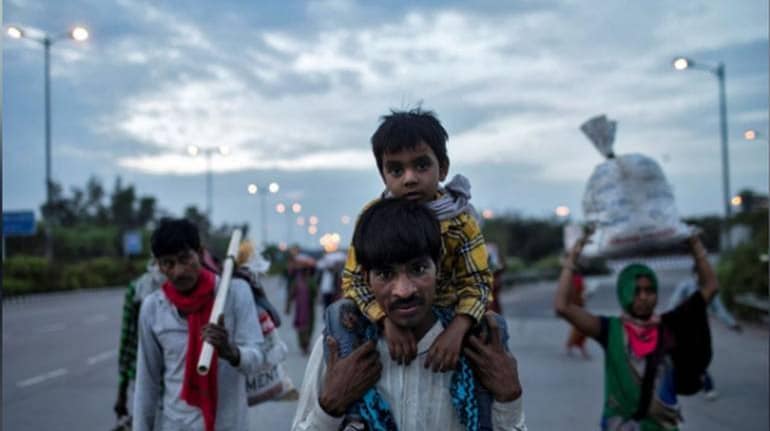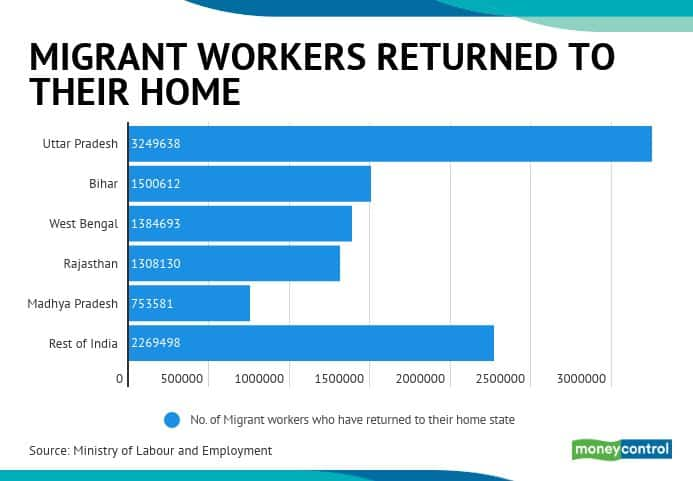
Of all migrant workers who returned home during pandemic, 75% hail from 5 states: Labour Ministry data
The labour ministry put forth this data in Parliament in response to a query seeking state-wise details of the number of labourers who had migrated to their hometowns from cites or their work places due to loss of jobs.
by Moneycontrol NewsOf all the migrant workers who returned home during the coronavirus pandemic, 75 percent hailed from five states, data from the Ministry of Labour and Employment showed. More than 1.04 crore migrant workers across the country headed back to their home states amid the pandemic-led livelihood crisis.
The labour ministry put forth this data in Parliament during the session on September 14, in response to an unstarred question seeking state-wise details pertaining to the number of labourers who had migrated to their hometowns from cites or their work places due to loss of jobs. Five states, namely, Uttar Pradesh, Bihar, West Bengal, Rajasthan and Madhya Pradesh, saw the highest number of migrant workers return amid the pandemic.

The query also sought details regarding assistance provided by the Centre to states to help rehabilitate these labourers and give them employment.
COVID-19 Vaccine
Frequently Asked Questions
View more
How does a vaccine work?
A vaccine works by mimicking a natural infection. A vaccine not only induces immune response to protect people from any future COVID-19 infection, but also helps quickly build herd immunity to put an end to the pandemic. Herd immunity occurs when a sufficient percentage of a population becomes immune to a disease, making the spread of disease from person to person unlikely. The good news is that SARS-CoV-2 virus has been fairly stable, which increases the viability of a vaccine.
How many types of vaccines are there?
There are broadly four types of vaccine — one, a vaccine based on the whole virus (this could be either inactivated, or an attenuated [weakened] virus vaccine); two, a non-replicating viral vector vaccine that uses a benign virus as vector that carries the antigen of SARS-CoV; three, nucleic-acid vaccines that have genetic material like DNA and RNA of antigens like spike protein given to a person, helping human cells decode genetic material and produce the vaccine; and four, protein subunit vaccine wherein the recombinant proteins of SARS-COV-2 along with an adjuvant (booster) is given as a vaccine.
What does it take to develop a vaccine of this kind?
Vaccine development is a long, complex process. Unlike drugs that are given to people with a diseased, vaccines are given to healthy people and also vulnerable sections such as children, pregnant women and the elderly. So rigorous tests are compulsory. History says that the fastest time it took to develop a vaccine is five years, but it usually takes double or sometimes triple that time.
Responding to the question, the government said, "In order to mitigate the financial crisis of the migrant workers and protect them against the economic disruptions due to the outbreak of the COVID-19 pandemic and Country-wide lockdown, the Central Government has taken numerous measures to provide them financial assistance, food packages ration, and other benefits."
The Centre also said that a Rs 1.70 lakh crore-relief package under the Pradhan Mantri Garib Kalyan Yojana (PMGKY) was announced in order to help the poor people and migrant workers, as well as their families and dependents, fight the battle against coronavirus.
Union Labour Minister Santosh Kumar Gangwar said, "In order to provide employment to migrant workers at their native places the Government has launched a number of schemes like Garib Kalyan Rojgar Abhiyaan to boost employment and livelihood opportunities, Anganwadi Service, employment in Food Processing Industries, Prime Minister Employment Generation Program, Scheme for the regeneration of Traditional Industries, Gram Udyog Vikas Yojana, identification of ongoing works/new works for road construction."